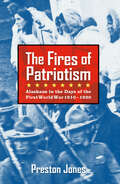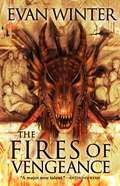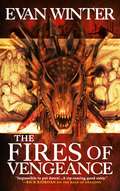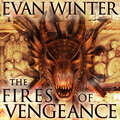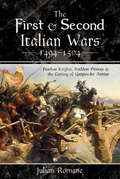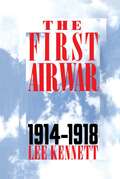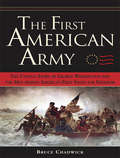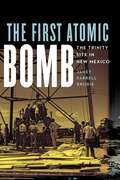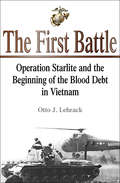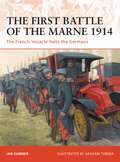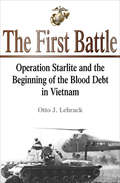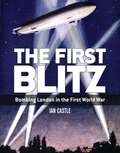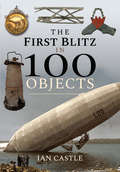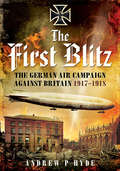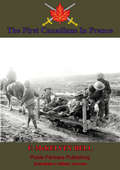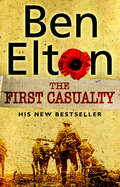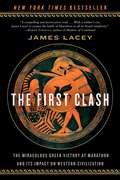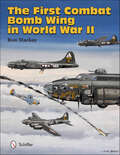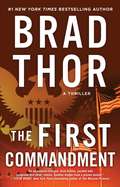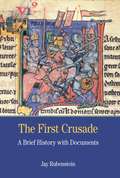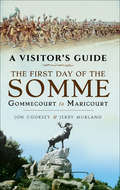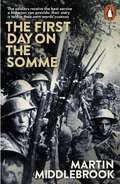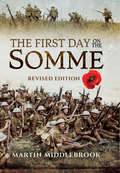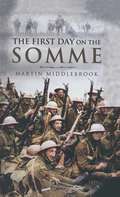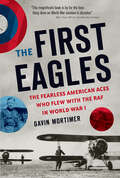- Table View
- List View
The Fires of Patriotism: Alaskans in the Days of the First World War 1910-1920
by Preston JonesThe little-known history of Alaska&’s participation in World War I—long before it became a state—includes photos. In the early twentieth century, Alaska was facing an exciting future as the newest US territory. Yet just five years after its official designation, the country entered World War I and citizens were called to fight. Despite the threat of a looming economic collapse, Alaska sent more people per capita to war than any other state and displayed a patriotism that rivaled that of any of the states. The Fires of Patriotism explores Alaska&’s wartime experience, bringing to light new stories and new characters from a decade that shook the world. This multifaceted book explores the era through engaging stories and rare photos, offering a fresh perspective on World War I from a marginal land that forged its place in the greater unity of the country.
The Fires of Vengeance: The Burning, Book Two (The Burning #2)
by Evan Winter'CAPTIVATING EPIC FANTASY FROM A MAJOR NEW TALENT' Anthony Ryan, on The Rage of DragonsDesperate to delay an impending attack by the indigenous people of Xidda, Tau and his queen craft a dangerous plan. If Tau succeeds, the queen will have the time she needs to assemble her forces and launch an all-out assault on her own capital city, where her sister is being propped up as the 'true' Queen of the Omehi.If the city can be taken, if Tsiora can reclaim her throne and reunite her people, then the Omehi might have a chance to survive the coming onslaught.THE FIRES OF VENGEANCE CONTINUES THE UNMISSABLE EPIC FANTASY SERIES THAT BEGAN WITH EVAN WINTER'S ACCLAIMED DEBUT THE RAGE OF DRAGONSPraise for The Rage of Dragons:'Intense, inventive and action-packed from beginning to end - a relentlessly gripping, brilliant read' James Islington, author of The Shadow of What Was Lost'Stunning debut fantasy' Publishers Weekly'Intense, vivid and brilliantly realised - a necessary read'Anna Smith Spark, author of The Court of Broken Knives'Impossible to put down' Rick Riordan'People ask the last book I couldn't put down, and I tell them The Rage of Dragons. The tension rises with every page until you fear it will break you in two' Peter V. Brett, bestselling author of The Painted Man'Fans of Anthony Ryan's Blood Song will love this' Django Wexler, author of The Thousand Names'A Xhosa-inspired world complete with magic, dragons, demons and curses, The Rage of Dragons takes classic fantasy and imbues it with a fresh and exciting twist' Anna Stephens, author of Godblind
The Fires of Vengeance: The Burning, Book Two (The Burning #2)
by Evan WinterIn order to reclaim her throne and save her people, an ousted queen must join forces with a young warrior in the second book of this"relentlessly gripping, brilliant" epic fantasy series from a breakout author (James Islington).Tau and his Queen, desperate to delay the impending attack on the capital by the indigenous people of Xidda, craft a dangerous plan. If Tau succeeds, the Queen will have the time she needs to assemble her forces and launch an all out assault on her own capital city, where her sister is being propped up as the 'true' Queen of the Omehi.If the city can be taken, if Tsiora can reclaim her throne, and if she can reunite her people then the Omehi have a chance to survive the onslaught.The BurningThe Rage of DragonsThe Fires of Vengeance
The Fires of Vengeance: The Burning, Book Two (The Burning #6)
by Evan Winter'CAPTIVATING EPIC FANTASY FROM A MAJOR NEW TALENT' Anthony Ryan, on The Rage of DragonsDesperate to delay an impending attack by the indigenous people of Xidda, Tau and his queen craft a dangerous plan. If Tau succeeds, the queen will have the time she needs to assemble her forces and launch an all-out assault on her own capital city, where her sister is being propped up as the 'true' Queen of the Omehi.If the city can be taken, if Tsiora can reclaim her throne and reunite her people, then the Omehi might have a chance to survive the coming onslaught.THE FIRES OF VENGEANCE CONTINUES THE UNMISSABLE EPIC FANTASY SERIES THAT BEGAN WITH EVAN WINTER'S ACCLAIMED DEBUT THE RAGE OF DRAGONSPraise for The Rage of Dragons:'Intense, inventive and action-packed from beginning to end - a relentlessly gripping, brilliant read' James Islington, author of The Shadow of What Was Lost'Stunning debut fantasy' Publishers Weekly'Intense, vivid and brilliantly realised - a necessary read'Anna Smith Spark, author of The Court of Broken Knives'Impossible to put down' Rick Riordan'People ask the last book I couldn't put down, and I tell them The Rage of Dragons. The tension rises with every page until you fear it will break you in two' Peter V. Brett, bestselling author of The Painted Man'Fans of Anthony Ryan's Blood Song will love this' Django Wexler, author of The Thousand Names'A Xhosa-inspired world complete with magic, dragons, demons and curses, The Rage of Dragons takes classic fantasy and imbues it with a fresh and exciting twist' Anna Stephens, author of Godblind
The First & Second Italian Wars, 1494–1504: Fearless Knights, Ruthless Princes & the Coming of Gunpowder Armies
by Julian RomaneA historical analysis of the course of military operations and political machinations in Italy at the turn of the sixteenth century.The First and Second Italian Wars begins with the French conquest of much of Italy. But the French hold collapsed. The second French invasion gained Northern Italy. This time, the French allied with the Pope’s son, Cesare Borgia. Cesare managed to double deal too many people; his efforts ended in disaster. The French agreement with the Spanish allowed them to retake Naples only to be defeated at the Garigliano by the famous general, Gonzalo de Cordoba.These wars were not just another series of medieval fights. These battles were different from what had gone before: the French utilized a new method of artillery transport; the Spanish commander formulated a new system of military unit organization, and Cesare Borgia sought different systems of raising troops and forming states. And all the powers managed to spend vast amounts of money the likes of which no one had imagined before. This was the emergence of the so-called Military Revolution.Praise for The First and Second Italian Wars 1494–1504“An amazing account of medieval warfare between two of Europe’s principle nations.” —Books Monthly (UK)“This is a fascinating, detailed look at these crucial wars, placing the military campaigns in their political context—the world that inspired the writings of Machiavelli, and you can see where he got his inspiration from!” —History of War
The First Air War: 1914-1918
by Lee Kennett"In this fascinating book, Lee Kennett tells of (World War I fliers and) their experiences on all fronts and skillfully places them in proper context" (Edward M. Coffman, author of The Old Army"). "A welcome and long overdue addition to the literature of military aviation."--Richard P. Hallion, Lindbergh Professor, National Air and Space Museum, Smithsonian Institution.
The First American Army: The Untold Story of George Washington and the Men Behind America's First Fight for Freedom
by Bruce ChadwickThis is the first book that offers a you-are-there look at the American Revolution through the eyes of the enlisted men. Through searing portraits of individual soldiers, Bruce Chadwick, author of George Washington's War, brings alive what it was like to serve then in the American army. With interlocking stories of ordinary Americans, he evokes what it meant to face brutal winters, starvation, terrible homesickness and to go into battle against the much-vaunted British regulars and their deadly Hessian mercenaries. The reader lives through the experiences of those terrible and heroic times when a fifteen-year-old fifer survived the Battle of Bunker Hill, when Private Josiah Atkins escaped unscathed from the bloody battles in New York and when a doctor and a minister shared the misery of the wounded and dying. These intertwining stories are drawn from their letters and never-before-quoted journals found in the libraries belonging to the camps where Washington quartered his troops during those desperate years.
The First Atomic Bomb: The Trinity Site in New Mexico (America’s Public Lands)
by Janet Farrell BrodieOn July 16, 1945, just weeks before the atomic bombing of Hiroshima and Nagasaki that brought about the surrender of Japan and the end of World War II, the United States unleashed the world&’s first atomic bomb at the Trinity testing site located in the remote Tularosa Valley in south-central New Mexico. Immensely more powerful than any weapon the world had seen, the bomb&’s effects on the surrounding and downwind communities of plants, animals, birds, and humans have lasted decades. In The First Atomic Bomb Janet Farrell Brodie explores the history of the Trinity test and those whose contributions have rarely, if ever, been discussed—the men and women who constructed, served, and witnessed the first test—as well as the downwinders who suffered the consequences of the radiation. Concentrating on these ordinary people, laborers, ranchers, and Indigenous peoples who lived in the region and participated in the testing, Brodie corrects the lack of coverage in existing scholarship on the essential details and everyday experiences of this globally significant event. The First Atomic Bomb also covers the environmental preservation of the Trinity test site and compares it with the wide range of atomic sites now preserved independently or as part of the new Manhattan Project National Historical Park. Although the Trinity site became a significant node for testing the new weapons of the postwar United States, it is known today as an officially designated National Historic Landmark. Brodie presents a timely, important, and innovative study of an explosion that carries special historical weight in American memory.
The First Battle
by Otto LehrackThe First Battle is a graphic account of the first major clash of the Vietnam War. On August 18, 1965, regiment fought regiment on the Van Tuong Peninsula near the new Marine base at Chu Lai. On the American side were three battalions of Marines under the command of Colonel Oscar Peatross, a hero of two previous wars. His opponent was the 1st Viet Cong Regiment commanded by Nguyen Dinh Trong, a veteran of many fights against the French and the South Vietnamese. Codenamed Operation Starlite, this action was a resounding success for the Marines and its result was cause for great optimism about America's future in Vietnam. Those expecting a book about Americans in battle will not be disappointed by the detailed descriptions of how the fight unfolded. Marine participants from private to colonel were interviewed during the book's research phase. The battle is seen from the mud level by those who were at the point of the spear. But this is not just another war story told exclusively from the American side. In researching the book, the author talked with and walked the battlefield with men who fought with the 1st Viet Cong Regiment. All were accomplished combat veterans years before the U.S. entry into the war. The reader is planted squarely in America in 1965, the year that truly began the long American involvement. Operation Starlite sent the Vietnam War into the headlines across the nation and into the minds of Americans, where it took up residence for more than a decade. Starlite was the first step in Vietnam's becoming America's tar baby. The subtitle of the book is: Operation Starlite and the Beginning of the Blood Debt in Vietnam. Blood debt, han tu in Vietnamese, can mean revenge, debt of honor, or blood owed for blood spilled. The Blood Debt came into Vietnamese usage early in the war with the United States. With this battle, the Johnson Administration began compiling its own blood debt, this one to the American people. The book also looks at the ongoing conflict between the US Army and the US Marines about the methodology of the Vietnam War. With decades of experience with insurrection and rebellion, the Marines were institutionally oriented to base the struggle on pacification of the population. The Army, on the other hand, having largely trained to meet the Soviet Army on the plains of Germany, opted for search-and-destroy missions against Communist main force units. The history of the Vietnam War is littered with many "what if's." This may be the biggest of them.
The First Battle of the Marne 1914
by Ian SumnerOsprey's study of the Battle of the Marne, which was one of the decisive encounters of World War I (1914-1918), saving France from a catastrophic defeat that would almost certainly have knocked her out of the war. Germany's failure to defeat the French committed her to a war on two fronts, which would lead to trench warfare and the war of attrition that the General Staff had hoped to avoid. The conduct of the battle served to make and break the reputation of commanders and subordinates alike. Although not an decisive defeat, the battle was a strategic Allied victory. Further attempts by each side to outflank the other led to the formation of a continuous front from the North Sea to Switzerland, which set the pattern for the rest of the war. This title presents the origins of the campaign, followed by a brief chronology, before detailing the opposing commanders and armies. It then breaks out the French orders of battle and the German's opposing plans, the outcome of the fighting and the aftermath of the battle. The book concludes with a look at the battlefield today and suggestions for further reading.
The First Battle: Operation Starlite and the Beginning of the Blood Debt in Vietnam
by Otto J. Lehrack&“[A] brief but well-told and well-researched account . . . a good description of early U.S. Marine deployments to Vietnam&” (HistoryNet). The First Battle is a graphic account of the Vietnam War&’s first major clash. On August 18, 1965, regiment fought regiment on the Van Tuong Peninsula near the new Marine base at Chu Lai. On the American side were three battalions of Marines under the command of Col. Oscar Peatross, a hero of two previous wars. His opponent was the 1st Viet Cong Regiment commanded by Nguyen Dinh Trong, a veteran of many fights against the French and the South Vietnamese. Codenamed Operation Starlite, this action was a resounding success for the Marines, and its result was cause for great optimism about America&’s future in Vietnam. Blood debt, han tu in Vietnamese, can mean revenge, debt of honor, or blood owed for blood spilled. The blood debt came into Vietnamese usage early in the war with the United States. With this battle, the Johnson Administration began compiling its own blood debt, this one to the American people. The book also looks at the ongoing conflict between the US Army and the US Marines about the methodology of the Vietnam War. With decades of experience with insurrection and rebellion, the Marines were institutionally oriented to base the struggle on pacification of the population. The Army, on the other hand, having largely trained to meet the Soviet Army on the plains of Germany, opted for search-and-destroy missions against Communist main force units. The history of the Vietnam War is littered with many &“what ifs.&” This may be the biggest of them.
The First Blitz
by Ian CastleThis book tells the story of Germany's strategic air offensive against Britain, and how it came to be neutralized. The first Zeppelin attack on London came in May 1915 - and with it came the birth of a new arena of warfare, the 'home front'. German airships attempted to raid London on 26 separate occasions between May 1915 and October 1917, but only reached the capital and bombed successfully on nine occasions. From May 1917 onwards, this theatre of war entered a new phase as German Gotha bombers set out to attack London in the first bomber raid. London's defences were again overhauled to face this new threat, providing the basis for Britain's defence during World War II.This comprehensive volume tells the story of the first aerial campaign in history, as the famed Zeppelins, and then the Gotha and the massive Staaken 'Giant' bombers waged war against the civilian population of London in the first ever 'Blitz'.
The First Blitz in 100 Objects (In 100 Objects Ser.)
by Ian CastleA visual history of this forgotten WWI bombing campaign: &“A fantastic book. Remnants of stained glass windows, grocery shop scales . . . and so much more.&” —War History Online The First World War ushered in many new and increasingly deadly weapons and strategies—none more so than Germany&’s sustained aerial bombing campaign against Britain, which opened an entirely new theatre of war—the Home Front. It was a shocking awakening to twentieth-century warfare for the military and civilians alike. There are still fascinating glimpses of this first air campaign, long overshadowed by the Blitz of World War II—to be found in the streets of British towns and cities. Often unnoticed, each tells its own dramatic tale of death and destruction, or maybe of heroism and narrow escapes. Museums hold tantalizing reminders of the air raids, from complete aircraft that defended the country to relics of great Zeppelins that initially brought terror to the British population but ultimately were doomed to become nothing more than great heaps of burnt and twisted wreckage. This first-time assault from the air both terrified and fascinated citizens—and unexpectedly, a significant trade in air raid souvenirs developed, from postcards of wrecked houses and bomb craters to china models of Zeppelins and their bombs and pieces of Zeppelin wreckage. And among the 100 Objects brought together in this book, there can also be found tales of resilience, humor, and determination—which all have their place in the story of this First Blitz
The First Blitz: The German Air Campaign Against Britain, 1917–1918
by Andrew P. Hyde“An interesting account of the German air raids of the First World War, with a better focus on the human face of the raids” (HistoryOfWar.org). In 1917, the Germans launched a major air campaign against the British mainland, which shocked the whole nation and terrorized the southeast of England. These attacks by German bombers caused hundreds of deaths and injuries, but until now, the full details of these raids have never before been told. These range from the massacre of Canadian troops resting in Folkestone on May 25, 1917 to the widespread carnage of shoppers a couple of miles away in the city center. Sheerness, then a major dockyard for the Royal Navy, barely escaped a similar fate when it too was singled out for the same treatment, and a 50kg bomb struck Upper North Street School in London’s Poplar on June 13, 1917. It not only took the lives of eighteen schoolchildren, many as young as five years, but also crippled and mutilated twice as many again. Terrible as this was, it was just one of scores of similar tragedies, which terrified the populace of London and horrified the world. The account of this campaign—plus the political and military circumstances surrounding it—follow years of original and painstaking research, interviews, and correspondence with those who remember that period. “This is a tight and carefully crafted piece of history. It has drama and a slice of shock and awe.” —War History Online “A clear winner from the first page.” —Indy Squadron Dispatch
The First Canadians In France, The Chronicle Of A Military Hospital In The War Zone
by Lt. Col. Frederick McKelvey BellLt. Col. Frederick McKelvey Bell holds an eminent place among the Canadians that were engaged in the war effort in France; his medical unit was the first of the Canadians to land and set to work in France in 1914. A distinguished doctor and medical officer, the author recounts his adventures and japes among his comrades in a relaxed and almost comic tone during the passage across the Atlantic. It is surprising that the sang-froid of he and his friends remained intact as they approached the front and the carnage which they encountered at the military hospital. Bell and his comrades provided vital care to the wounded of the British forces, and even some of the captured German soldiers, of whom he paints vivid portraits.
The First Casualty
by Ben Elton'A work of formidable imaginative scope' Daily Telegraph The first casualty when war comes is truth . . . Flanders, June 1917: a British officer and celebrated poet, is shot dead. , He is killed not by German fire, but while recuperating from shell shock well behind the lines. A young English soldier is arrested and, although he protests his innocence, charged with his murder.Douglas Kingsley is a conscientious objector, previously a detective with the London police, now imprisoned for his beliefs. He is released and sent to France in order to secure a conviction. Forced to conduct his investigations amidst the hell of The Third Battle of Ypres, Kingsley soon discovers that both the evidence and the witnesses he needs are quite literally disappearing into the mud that surrounds him.Ben Elton's tenth novel is a gut-wrenching historical drama which explores some fundamental questions:What is murder? What is justice in the face of unimaginable daily slaughter? And where is the honour in saving a man from the gallows if he is only to be returned to die in a suicidal battle?
The First Clash: The Miraculous Greek Victory at Marathon--and Its Impact on Western Civilization
by Jim LaceyMarathon--one of history's most pivotal battles. Its very name evokes images of almost superhuman courage, endurance, and fighting spirit. But until now, the story of what happened at Marathon has been told exclusively through the narrow viewpoint of specialists in antiquity. In this eye-opening new book, acclaimed journalist Jim Lacey, both a military historian and a combat veteran, takes a fresh look at Marathon and reveals why the battle happened, how it was fought, and whether, in fact, it saved Western civilization. Lacey brilliantly reconstructs the world of the fifth century B.C. leading up to the astonishing military defeat of the Persian Empire by the vastly undermanned but determined Greek defenders. Using the seminal work of Herodotus as his starting point, Lacey reconstructs the tactical and strategic scenario of the battle, including how many combatants each side might have used and who actually led the Greeks. He also disputes the long-repeated myths of Athenian inexperience and effete Persian arrogance. With the kind of vivid detail that characterizes the best modern war reportage, Lacey shows how the heavily armed Persian army was shocked, demoralized, and ultimately defeated by the relentless assault of the Athenian phalanx, which battered the Persian line in a series of brutal attacks. He reveals the fascinating aftermath of Marathon, how its fighters became the equivalent of our "Greatest Generation," and challenges the view of many historians that Marathon ultimately proved the Greek "Western way of war" to be the superior strategy for fighting--and winning--battles to the present day. Immediate, visceral, and full of new analyses that defy decades of conventional wisdom, The First Clash is a superb interpretation of a conflict that indeed made the world safe for Aristotle, Plato, and our own modern democracy. But it was also a battle whose legacy and lessons have often been misunderstood--perhaps, now more than ever, at our own peril.
The First Combat Bomb Wing in WWII
by Ron MackayThis is a study of one of the 8th USAAF’s sub-units. The 1st Combat Bomb Wing (1CBW), created on 13 September 1943, was preceded first by the 1st Bomb Wing, and then the 101st Provisional Bomb Wing, which included the 91BG as an element. By then, the 91BG was joined by the 351BG and 381BG, with the 351BG later displaced by the 398BG. The operational experience of these units virtually spanned the entire 33 months of the "Mighty Eighth’s" existence and the often costly but finally successful campaign to deny Hitler’s Germany the means with which to pursue its warped dreams of conquest.
The First Commandment: A Thriller (The Scot Harvath Series #6)
by Brad ThorFrom #1 New York Times and #1 Wall Street Journal bestselling author Brad Thor, the explosive international thriller featuring Navy SEAL turned Homeland Security operative Scot Harvath, who somewhere, somehow, has left the wrong person alive.Six months ago: in the dead of the night, five of the most dangerous detainees in the war on terror are pulled from their isolation cells in Guantanamo Bay, held at gunpoint, and told to strip off their orange jumpsuits. Issued civilian clothes and driven to the base airfield, they are loaded aboard a Boeing 727 and set free. Present day: covert counterterrorism agent Scot Harvath awakens to discover that his world has changed violently—and forever. A sadistic assassin with a personal vendetta is wreaking havoc of biblical proportions. Unleashing nightmarish horrors on those closest to Harvath, the attacker thrusts everything Harvath holds dear—including his life—into absolute peril. Ordered by the president to stay out of the investigation, Harvath is forced to mount his own operation to uncover the conspiracy and to exact revenge. When he discovers a connection between the attacks and a group of prisoners secretly released from Guantanamo, Harvath must ask himself previously unthinkable questions about the organizations and the nation he has spent his life serving. A renegade from his own government, Harvath will place his life on the line as his search for the truth draws him into a showdown with one of the most dangerous men on the face of the earth. Brad Thor roars through this nonstop adventure full of international intrigue, twisted betrayals, and ultimate revenge.
The First Day of the Somme: Gommecourt to Maricourt, 1 July 1916 (A Visitor's Guide)
by Jon Cooksey Jerry MurlandMany guidebooks cover the Somme offensive in 1916, the five-month struggle that has come to be seen as one of the defining episodes in the history of the fighting on the Western Front during the First World War. But no previous guide has concentrated on the first day, 1 July 1916, when the British Army suffered around 60,000 casualties. That is why, on the centenary of that great battle, this new volume from Pen & Sword is so timely. In a series of tours that can be walked, biked or driven, expert authors Jon Cooksey and Jerry Murland take the visitor along the eighteen-mile front line that was the starting point for the Somme offensive, from Gommecourt in the north to Maricourt in the south. The tours allow the visitor to trace the entire course of the opening day on the ground. In vivid detail the authors describe what happened, where it happened and why and which units were involved, and point out the sights that remain for the visitor to see.
The First Day on the Somme: 1 July 1916
by Martin MiddlebrookThe soldiers receive the best service a historian can provide: their story is told in their own words - Guardian'For some reason nothing seemed to happen to us at first; we strolled along as though walking in a park. Then, suddenly, we were in the midst of a storm of machine-gun bullets and I saw men beginning to twirl round and fall in all kinds of curious ways' On 1 July 1916, a continous line of British soldiers climbed out from the trenches of the Somme into No Man's Land and began to walk towards dug-in German troops armed with machine-guns. By the end of the day there were more than 60,000 British casualties - a third of them fatal.Martin Middlebrook's now-classic account of the blackest day in the history of the British army draws on official sources from the time, and on the words of hundreds of survivors: normal men, many of them volunteers, who found themselves thrown into a scene of unparalleled tragedy and horror.
The First Day on the Somme: Revised Edition
by Martin MiddlebrookA history of the British Army&’s experience at the Battle of the Somme in France during World War I. After an immense but useless bombardment, at 7:30 AM on July 1, 1916, the British Army went over the top and attacked the German trenches. It was the first day of the battle of the Somme, and on that day, the British suffered nearly 60,000 casualties, two for every yard of their front. With more than fifty times the daily losses at El Alamein and fifteen times the British casualties on D-day, July 1, 1916, was the blackest day in the history of the British Army. But, more than that, as Lloyd George recognized, it was a watershed in the history of the First World War. The Army that attacked on that day was the volunteer Army that had answered Kitchener&’s call. It had gone into action confident of a decisive victory. But by sunset on the first day on the Somme, no one could any longer think of a war that might be won. Martin Middlebrook&’s research has covered not just official and regimental histories and tours of the battlefields, but interviews with hundreds of survivors, both British and German. As to the action itself, he conveys the overall strategic view and the terrifying reality that it was for front-line soldiers.Revised in 2016 from the 1971 original edition.Praise for The First Day on the Somme&“The remembrance of those lives, difficult as it may be, will start in earnest now, with this wonderful book. It&’s almost like being there yourself... enough said.&”—Books Monthly (UK)
The First Day on the Somme: Revised Edition (Penguin History Ser.)
by Martin MiddlebrookA history of the British Army&’s experience at the Battle of the Somme in France during World War I. After an immense but useless bombardment, at 7:30 AM on July 1, 1916, the British Army went over the top and attacked the German trenches. It was the first day of the battle of the Somme, and on that day, the British suffered nearly 60,000 casualties, two for every yard of their front. With more than fifty times the daily losses at El Alamein and fifteen times the British casualties on D-day, July 1, 1916, was the blackest day in the history of the British Army. But, more than that, as Lloyd George recognized, it was a watershed in the history of the First World War. The Army that attacked on that day was the volunteer Army that had answered Kitchener&’s call. It had gone into action confident of a decisive victory. But by sunset on the first day on the Somme, no one could any longer think of a war that might be won. Martin Middlebrook&’s research has covered not just official and regimental histories and tours of the battlefields, but interviews with hundreds of survivors, both British and German. As to the action itself, he conveys the overall strategic view and the terrifying reality that it was for front-line soldiers.Praise for The First Day on the Somme&“The soldiers receive the best service a historian can provide: their story is told in their own words.&” —The Guardian (UK)
The First Eagles: The Fearless American Aces Who Flew with the RAF in World War I
by Gavin MortimerAn incredible history of the American WWI pilots who refused to be grounded. There was a time when the United States didn’t believe in aerial warfare. Wars, after all, were for men—not flying machines. When Europe went to war in the summer of 1914, the U.S. military boasted a measly collection of five aircraft, with no training programs or recruitment procedures in place. But that didn’t mean the country lacked skilled pilots. In fact, it was just the opposite. In The First Eagles, award-winning historian Gavin Mortimer engagingly profiles the restless, determined American aviators who grew tired of waiting for the their country to establish an aerial military force during World War I. It was these men who enlisted in Britain’s desperate and battered Royal Flying Corps when, in 1917, it opened a recruitment office in New York. After an intensive and deadly year of training that gave recruits a frighteningly realistic taste of the combat they would face, 247 fresh American RFC pilots were shipped over to Europe, with hundreds more following in the next two months. Twenty-eight of them claimed five or more kills to become feted as “aces,” their involvement lauded as pivotal to the Allied victory. In this book, Mortimer compiles their history through letters, diaries, memoirs, and archives from top museums in the United States and Britain—from John Donaldson, who left for France at age twenty and shot down seven Germans before being downed himself, to the Iaccaci brothers, who accounted for twenty-nine German aircraft between them. Complete with 150 period photographs, The First Eagles captures the bravery of these intrepid American pilots, who chose courage over idleness and saved the European skies.
